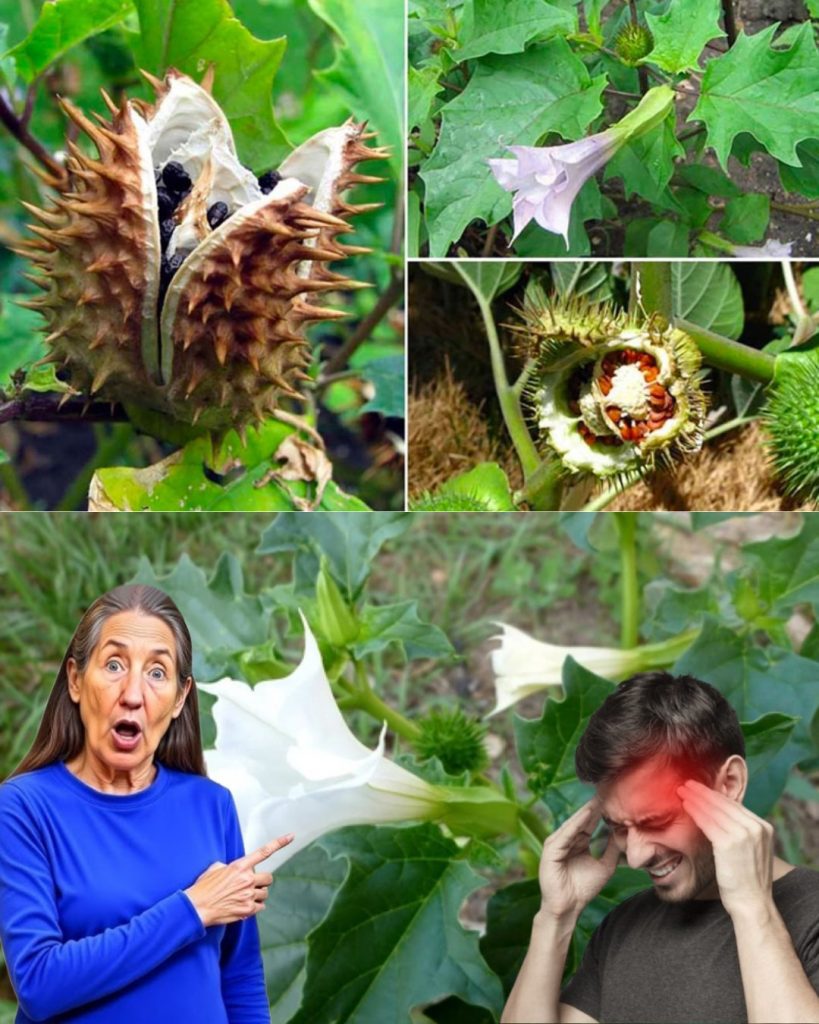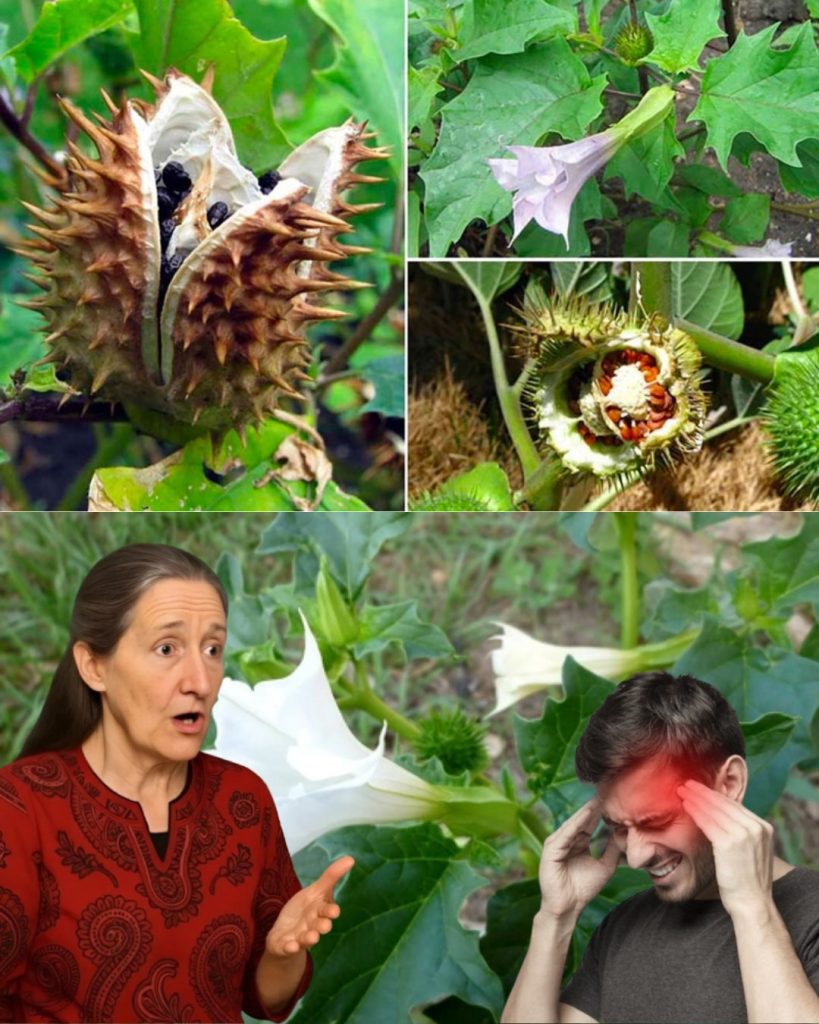In the quiet corners of gardens and along forgotten trails, a plant of haunting beauty sways in the breeze, its trumpet-shaped flowers glowing under moonlight. Datura, with its ethereal allure, beckons the curious and the unwary alike. But beneath its delicate petals lies a dangerous secret—a potent poison that has captivated, deceived, and destroyed for centuries. This is no ordinary flora; it’s a paradox of nature, a siren call wrapped in soft whites and purples, daring you to come closer while whispering warnings of peril. Step into the world of Datura, where beauty and danger dance a deadly waltz, and discover why this plant has enthralled humanity for ages.

🌿 A Plant Steeped in Mystique
Datura, often called jimsonweed, devil’s trumpet, or moonflower, belongs to the Solanaceae family, a lineage that includes both benign crops like tomatoes and notorious poisons like belladonna. Its flowers, which bloom in shades of white, purple, or yellow, unfurl at dusk, releasing a sweet, intoxicating fragrance that lures pollinators—and curious humans—into its orbit. Found across the globe, from the Americas to Asia, Datura thrives in disturbed soils, often appearing in places touched by human hands, as if summoned by our own recklessness.
Its allure isn’t just visual. Datura’s history is woven into the fabric of human culture, from ancient rituals to modern misadventures. Shamans once used it to commune with the divine, while thrill-seekers and the uninformed have stumbled into its grasp, often with dire consequences. What makes Datura so compelling? It’s the promise of transcendence, the whisper of forbidden knowledge, and the razor-thin line between ecstasy and agony.
🕯️ A History of Enchantment and Danger
Datura’s roots run deep in human history. In ancient India, it was revered as a sacred plant, linked to the god Shiva and used in spiritual ceremonies to induce visions. In the Americas, indigenous tribes employed Datura in rites of passage, believing it could bridge the mortal and spiritual realms. Yet, even in these sacred contexts, its power was respected and feared. Misjudge the dose, and the line between vision and madness blurs.
By the Middle Ages, Datura’s darker reputation emerged. European witches were said to use it in their potions, crafting brews that could induce delirium or mimic death. Sailors and soldiers, too, fell victim to its seductive pull, with historical accounts of accidental poisonings during long voyages or wartime foraging. Even today, Datura remains a cautionary tale, with emergency rooms reporting cases of reckless experimentation gone wrong. Its legacy is one of duality: a plant that offers profound insights but demands a steep price.
💀 The Poison Within: A Chemical Conspiracy
What makes Datura so dangerous? The answer lies in its chemistry. The plant contains potent alkaloids—tropane compounds like scopolamine, hyoscyamine, and atropine—that wreak havoc on the human body. These chemicals disrupt the central nervous system, leading to a cascade of effects: dilated pupils, racing heart, hallucinations, and, in severe cases, coma or death. A single seed pod, which can contain hundreds of tiny black seeds, holds enough power to alter reality—or end it.
Scopolamine, in particular, is notorious. Known as “devil’s breath” in some cultures, it can render victims compliant and disoriented, a property that has fueled urban legends of its use in crimes. Atropine, another key alkaloid, is used in modern medicine to treat certain conditions but becomes deadly in high doses. The line between a therapeutic dose and a fatal one is terrifyingly thin, making Datura a gamble no one should take lightly.
🌸 Beauty That Betrays
Datura’s beauty is its greatest weapon. Its flowers, which can span up to eight inches, are a study in elegance—soft, trumpet-shaped blooms that seem to glow in the twilight. The leaves, broad and slightly serrated, add to its lush appearance, while the spiky seed pods, often called “thorn apples,” hint at the danger within. This contrast—between inviting aesthetics and hidden menace—makes Datura a master of deception.
Gardeners often plant Datura for its ornamental appeal, unaware of its toxic nature. In warm climates, it thrives with little care, its resilience adding to its mystique. But this ease of cultivation comes with a warning: Datura doesn’t discriminate. A curious child, a wandering pet, or an uninformed forager can fall victim to its charm in moments.
🧠 The Mind’s Descent: Datura’s Hallucinogenic Grip
For those who ingest Datura, the experience is unlike any other. The hallucinations it induces are vivid, immersive, and often terrifying. Users report seeing shadowy figures, conversing with nonexistent people, or feeling as though they’ve been transported to another realm. Unlike psychedelics like LSD, which often retain a sense of control, Datura’s effects are chaotic and disorienting. Time distorts, reality fractures, and the boundary between dream and waking life dissolves.
Survivors of Datura poisoning describe a sense of being trapped in their own minds, unable to distinguish hallucination from reality. Physical symptoms—dry mouth, blurred vision, and searing heat—compound the mental torment. In high doses, the body shuts down, with seizures or respiratory failure marking the final stages. Even in small amounts, the effects can linger for days, leaving users shaken and wary.
🌍 Datura in the Modern World
Today, Datura remains a paradoxical presence. In some circles, it’s still used in alternative medicine or spiritual practices, though such uses are fraught with risk. Online forums buzz with stories of reckless experimentation, with thrill-seekers chasing its hallucinogenic high despite the warnings. Emergency rooms continue to see cases of Datura poisoning, often from misidentification or deliberate misuse.
Law enforcement, too, has taken note. In regions where Datura grows wild, authorities warn against its use, citing its potential for abuse and its role in accidental overdoses. Yet, the plant’s allure persists, fueled by its accessibility and the human fascination with the forbidden.

⚠️ A Warning to the Curious
Datura is not a plant to be trifled with. Its beauty is a trap, its promise of transcendence a lie that often leads to suffering. For every story of spiritual awakening, there are countless others of regret and loss. If you encounter Datura in the wild or in a garden, admire it from afar. Its flowers may call to you, but their song is one of danger.
For gardeners, the advice is clear: know what you’re planting. If Datura is part of your landscape, ensure it’s out of reach of children and pets. For foragers, the rule is simpler: never consume a plant unless you’re certain of its identity. Datura’s spiky pods and fragrant blooms are unmistakable once you know what to look for, but ignorance can be deadly.
🌟 The Eternal Allure of the Forbidden
Why does Datura continue to captivate us? It’s more than just its beauty or its danger. It’s the way it challenges our understanding of nature, blurring the line between medicine and poison, beauty and terror. It’s a reminder that the world is full of mysteries, some of which are best left unexplored. Datura doesn’t just grow in the soil; it takes root in our imaginations, feeding on our curiosity and our desire to push boundaries.
As you walk through a garden or hike along a trail, keep an eye out for those glowing trumpets swaying in the dusk. They’re a testament to nature’s complexity—a beauty that can heal or harm, depending on how closely you dare to look. Datura’s story is one of seduction and consequence, a tale as old as humanity itself, and it’s a story that will continue to unfold as long as we’re drawn to the unknown.









